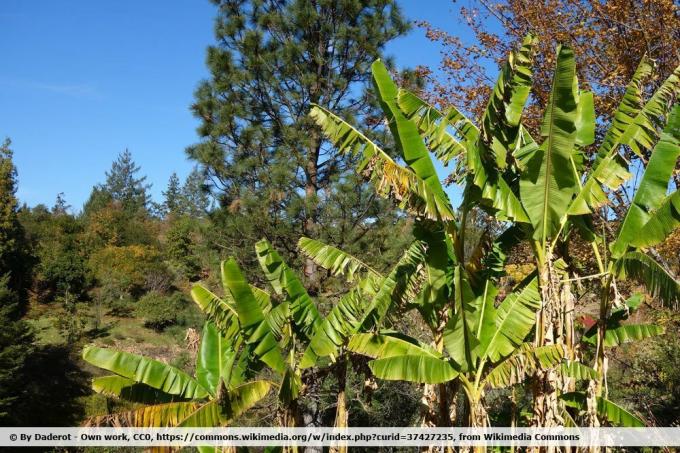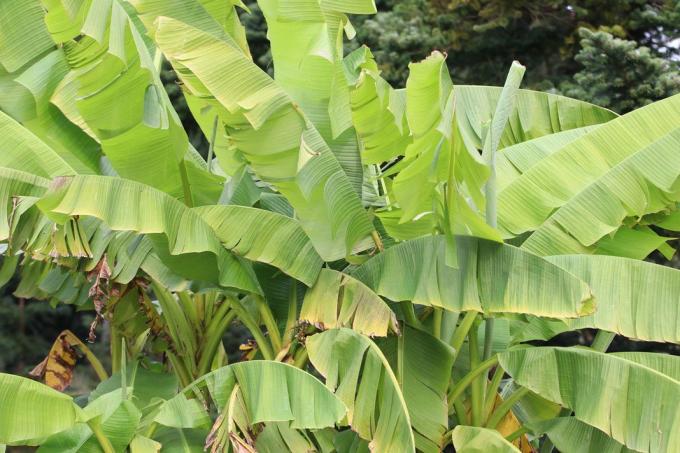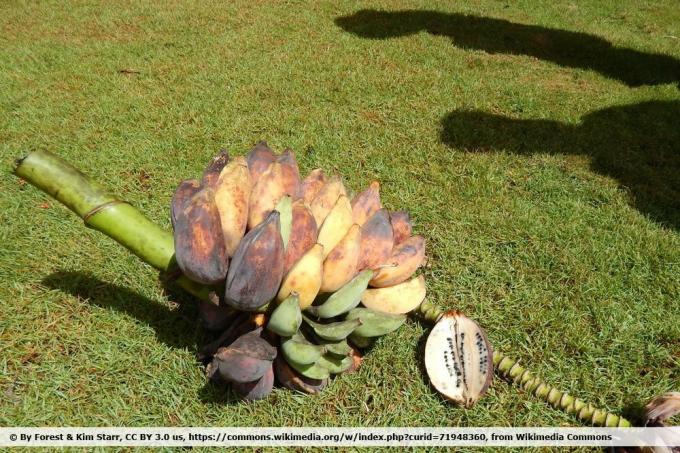
table of contents
- Hardy banana varieties
- Darjeeling banana
- Real Japanese fiber banana
- Fake Japanese fiber banana
- Hajaray banana
- Nagaland banana
- Yangtze Banana
- Yunnan banana
Bananas are an exotic fruit and can be found in the wild in tropical to subtropical Asia, among other places. However, did you know that you can also grow bananas in the garden at home? Because many varieties are frost hardy and can easily survive the winter outdoors. We'll show you which seven varieties are suitable for outdoor cultivation!
Hardy banana varieties
Bananas are known to be exotic fruits. But there are also varieties that thrive in our latitudes. Some banana varieties are even hardy. We present 7 varieties of bananas for the field.
Darjeeling banana
The Darjeeling banana originally comes from north-eastern India and can reach a height of up to seven meters in the wild. Not only does it have long, broad leaves, it also forms edible bananas. However, the sweet bananas are fuller Seedsthat can sometimes be hard-shelled. In local regions, however, the hardy Darjeeling banana is usually a bit smaller and a fruit harvest is probably not to be expected. The summer in local regions is simply too short for this, so that the bananas cannot ripen completely. As a decorative plant, it is still convincing, which is why it can be planted outdoors.
- Latin name: Musa sikkimensis
- Origin: northeastern India, Nepal, Sikkim, Bhutan, Bangladesh
- Height: 6 - 7 m, in local regions about 3 - 5 m
- Flowering period: July and August
- Flower color: red-purple
- Fruits: edible, sweet
- hardy: down to -15 ° C

Note: The Darjeeling banana is easy to grow from seeds.
Real Japanese fiber banana
The real Japanese fiber banana is best planted only when it is a bit older. If it has already formed Kindel and its rhizome is partially lignified, the ideal time is to plant out. In local regions, the real Japanese fiber banana can survive mild winters, provided it is equipped with frost protection. Their winter hardiness can vary depending on their origin, with specimens from the north Indian Himalayas and the Chinese mountains usually showing a more pronounced frost hardiness. In its country of origin, the Banana plant can reach a height of over four meters and also bear fruit. A fruit harvest is not to be expected in local regions, but that is not a problem. Because the bananas are full of seeds and inedible.
- Latin name: Musa balbisiana
- Synonyms: Wild plantain
- Origin: North India, China, Southeast Asia
- Height: over 4.5 m
- winter hardy: short term down to -9 ° C
Fake Japanese fiber banana
One of the hardiest banana plants is the false Japanese fiber banana. Thanks to its frost resistance, it can withstand temperatures as low as -12 ° C. Nevertheless, it is advisable to additionally protect them from frost with leaves and brushwood. So that the false Japanese fiber banana grows and thrives splendidly, it should be placed in a sunny and sheltered location. It has a high need for nutrients and water, which is why the soil should be kept evenly moist. With proper care, the banana plant grows quickly and can flower from the age of five.
- Latin name: Musa basjoo
- Synonyms: Japanese fiber banana, garden banana
- Origin: Ryukyu (Japanese island)
- Height: 3 - 4 m
- Flowering time: summer
- Flower color: green-yellow
- Fruits: mini bananas
- hardy: down to -12 ° C without protection

Note: Popular frost-hardy varieties of Musa basjoo include “Nana” and “Sapporro”.
Hajaray banana
The Hajaray banana is also a possible winter hardy candidate for outdoor use, because it is also frost hardy. The banana plant can withstand temperatures of down to -10 ° C outdoors, with frost protection it can stand even lower temperatures. The fruits of the Hajaray banana are eaten in their country of origin because they are seedless and very tasty. In local regions, on the other hand, hobby gardeners can enjoy the decorative leaves, which are reddish in color on the underside.
- Latin name: Musa sp. Hajaray Hybrid
- Synonyms: Eastern banana hybrids
- Origin: Northeast India
- hardy: down to -10 ° C
Nagaland banana
The Nagaland banana is an absolute eye-catcher in the home garden: Both the leaves and the flowers of this banana plant are extremely decorative. The leaves are frosted white and blue and have a dark red central rib on the underside. The flowers, on the other hand, are surrounded by a red bract that is orange on the inside. The pseudo trunk is also colorful, because it is dark red to purple-red. In its country of origin, the Nagaland banana also produces slender, narrow fruits.
- Latin name: Musa nagensium
- Origin: East India, Nagaland
- Height: up to 6 m
- Flower color: blackish outside, crimson red inside
- hardy: down to -20 ° C
Yangtze Banana
The Yangtze banana is still a very new variety because it has only been in Germany since 2001. Since then, this variety has established itself as a popular garden plant because it can easily survive the local winter months. The banana plant grows very quickly, but is slender. Nevertheless, there should be enough space for the Yangtze banana, because it can reach a height of up to eight meters. Its very narrow leaves, which are green-blue or green-blue, are particularly vivid. are almost turquoise.
- Latin name: Musa sp. Yangtze
- Synonyms: Tibet Banana, Musa Tibet, Yangtze
- Origin: border area Myanmar, Zizang, Yunnan
- Height: up to 8 m
- hardy: down to -12 ° C
Yunnan banana
The Yunnan banana is also one of the varieties that can be easily grown outdoors. Because it can withstand temperatures of down to -20 ° C without any problems, provided it is protected accordingly. The Yunnan banana grows very quickly and can reach a height of over four meters. The male flowers, the decorative red-brown colored bracts, which in turn are adorned with yellow stripes on the sides, are particularly vivid. Visually an absolute eye-catcher, although the Yunnan banana usually does not bear any bananas in local regions.
- Latin name: Musa itinerans
- Origin: Southeast Asia, Northeast India, subtropical China
- Height: up to 4.5 m
- hardy: down to -20 ° C

